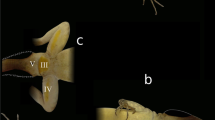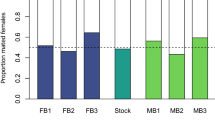Abstract
While male mate choice behaviour has been reported in many taxa, little is known about its plasticity and evolutionary consequences. In the damselfly Ischnura senegalensis, females exhibit colour dimorphism (gynomorph and andromorph). The body colour of gynomorphs changed ontogenetically in accordance with sexual maturation, while little change occurred in andromorphs. To test the male mate choice between sexually immature and mature females of both morphs, binary choice experiments were conducted. Virgin males that were reared separately from females after emergence did not show significant preference between sexually immature and mature females for both morphs, indicating that virgin males were unable to discriminate female reproductive status. On the other hand, males that had experienced copulation with gynomorphs preferred sexually mature gynomorphs to sexually immature ones. However, males that had experienced copulation with andromorphs could not discriminate between sexually immature and mature andromorphs, probably due to the absence of significant ontogenetic change in their thoracic colour. Therefore, female body colour is an important cue for males in discriminating between sexual maturation stages. Learned mate discrimination depending on copulation experience might help males to detect potential mates effectively and avoid sexually unreceptive immature female. We finally discuss the adaptive significance of the ontogenetic colour change in females.

Similar content being viewed by others
References
Amundsen T (2000) Why are female birds ornamented? Trends Ecol Evol 15:149–155
Amundsen T, Forsgren E (2001) Male mate choice selects for female coloration in fish. Proc Natl Acad Sci USA 98:13155–13160
Andersson M (1994) Sexual selection. Princeton University Press, New Jersey
Andersson J, Borg-Karlson AK, Wiklund C (2000) Sexual cooperation and conflict in butterflies: a male-transferred anti-aphrodisiac reduces harassment of recently mated females. Proc R Soc Lond B 267:1271–1275
Arnqvist G, Rowe L (2005) Sexual conflict. Princeton University Press, New Jersey
Bateman PW, Fleming PA (2006) Males are selective too: mating, but not courtship, with sequential females influences choosiness in male field crickets (Gryllus bimaculatus). Behav Ecol Sociobiol 59:577–581
Boggs CL (1995) Male nuptial gifts: phenotypic consequences and evolutionary implications. In: Leather SR, Hardie J (eds) Insect reproduction. CRC Press, New York, pp 215–242
Bonduriansky R (2001) The evolution of male mate choice in insects: a synthesis of ideas and evidence. Biol Rev 76:305–339
Bussière LF, Hunt JH, Stölting KN, Jennions MD, Brooks R (2008) Mate choice for genetic quality when environments vary: suggestions for empirical progress. Genetica 134:69–78
Clutton-Brock TH (2007) Sexual selection in males and females. Science 318:1882–1885
Clutton-Brock T (2009) Sexual selection in females. Anim Behav 77:3–11
Cooper G, Holland PWH, Miller PL (1996) Captive breeding of Ischnura elegans (Vander Linden): observations on longevity, copulation and oviposition (Zygoptera: Coenagrionidae). Odonatologica 25:261–273
Corbet PS (1999) Dragonflies: behaviour and ecology of Odonata. Harley, Colchester
Cordero A (1990) The inheritance of female polymorphism in the damselfly Ischnura graellsii (Rambur) (Odonata: Coenagrionidae). Heredity 64:341–346
Cordero Rivera A, Andrés J (2001) Estimating female morph frequencies and male mate preferences of polychromatic damselflies: a cautionary note. Anim Behav 61:F1–F6. doi:10.1006/anbe.2000.1572
Cordero A, Santolamazza Carbone S, Utzeri C (1998) Mating opportunities and mating costs are reduced in androchrome female damselflies, Ischnura elegans (Odonata). Anim Behav 55:185–197
Fincke OM (1987) Female monogamy in the damselfly Ischnura verticalis Say (Zygoptera: Coenagrionidae). Odonatologica 26:129–143
Fincke OM, Jödicke R, Paulson D, Schultz DT (2005) The evolution and frequency of female color morphs in Holarctic Odonata: why are male-like morphs typically the minority? Int J Odonatol 8:183–212
Fincke OM, Fargevieille A, Schultz TD (2007) Lack of innate preference for morph and species identity in mate-searching Enallagma damselflies. Behav Ecol Sociobiol 61:1121–1131
Fleishman LJ, Endler JA (2000) Some comments on visual perception and the use of video playback in animal behaviour studies. Acta Ethol 3:15–27
Gorb SN (1998) Visual cues in mate recognition by males of the damselfly, Coenagrion puella (L.) (Odonata: Coenagrionidae). J Insect Behav 11:73–92
Gorb SN (1999) Visual cues in mate recognition in the damselfly Ischnura elegans (Zygoptera: Coenagrionidae). Intl J Odonatol 2:83–93
Gosden TP, Svensson EI (2009) Density-dependent male mating harassment, female resistance and male mimicry. Am Nat 173:709–721
Hammers M, Sánchez-Guillén RA, Van Gossum H (2009) Differences in mating propensity between immature female color morphs in the damselfly Ischnura elegans (Insecta: Odonata). J Insect Behav 22:324–337
Hansen LTT, Amundsen T, Forsgren E (1999) Symmetry: attractive not only to females. Proc R Soc Lond B 266:1235–1240
Hinnekint B (1987) Population dynamics of Ischnura e. elegans (Vander Linden) (Insecta: Odonata) with special reference to morphological colour changes, female polymorphism, multiannual cycles and their influence on behaviour. Hydrobiology 146:3–31
Johnson C (1964) The inheritance of female dimorphism in the damselfly, Ischnura damula. Genetics 49:513–519
Johnson C (1966) Genetics of female dimorphism in Ischnura demorsa. Heredity 21:453–459
Jones KM, Monaghan P, Nager RG (2001) Male mate choice and female fecundity in zebra finches. Anim Behav 62:1021–1026
Joop G, Gillen A, Mikolajewski DJ (2007) Colour polymorphism in female Coenagrion puella: differences in egg shape (Odonata: Coenagrionidae). Intl J Odonatol 10:71–80
Kokko H, Johnstone RA (2002) Why is mutual mate choice not the norm? Operational sex ratios, sex roles and the evolution of sexually dimorphic and monomorphic signalling. Philos Trans R Soc Lond B 357:319–330
McLennan DA (1995) Male mate choice based upon female nuptial coloration in the brook stickleback, Culaea inconstans (Kirtland). Anim Behav 50:213–221
R Development Core Team (2009) R: a language and environment for statistical computing. R Foundation for Statistical Computing, Vienna. http://www.Rproject.org
Robertson HM (1985) Female dimorphism and mating behaviour in a damselfly, Ischnura ramburi: females mimicking males. Anim Behav 33:805–809
Rutowski R (1982) Epigamic selection as evidenced by courtship partner preferences in males of the checkered white butterfly, Pieris protodice. Anim Behav 30:108–112
Stoks R, De Bruyn L (1998) Unusual reproductive associations of Ischnura elegans. Notulae Odonatol 5:3–7
Svensson EI, Abbott J, Härdling R (2005) Female polymorphism, frequency dependence, and rapid evolutionary dynamics in natural populations. Am Nat 165:567–576
Takahashi Y, Watanabe M (2008) Male mate preference depending on the mating experience in the damselfly, Ischnura senegalensis (Rambur) (Odonata: Coenagrionidae). Jpn J Entomol 11:13–17 (In Japanese with English summary)
Takahashi Y, Watanabe M (2009) Diurnal changes and frequency dependence in male mating preference for female morphs in the damselfly Ischnura senegalensis (Rambur) (Odonata: Coenagrionidae). Entomol Sci 12:219–226
Takahashi Y, Watanabe M (2010a) Female reproductive success is affected by selective male harassment in the damselfly Ischnura senegalensis. Anim Behav 79:211–216
Takahashi Y, Watanabe M (2010b) Mating experience affecting male discrimination between sexes and female morphs in the damselfly, Ischnura senegalensis (Rambur) (Odonata: Coenagrionidae). Odonatologica 39:47–56
Takahashi Y, Watanabe M (2010c) Morph-specific fecundity and egg size in the female-dimorphic damselfly Ischnura senegalensis. Zool Sci 27:325–329
Takahashi Y, Yoshimura J, Morita S, Watanabe M (2010) Negative frequency-dependent selection in female color polymorphism of a damselfly. Evolution 64:3620–3628
Trivers RL (1972) Parental investment and sexual selection. In: Campbell B (ed) Sexual selection and the descent of man, 1871–1971. Aldine, Chicago, pp 136–179
Van Gossum H, Stoks R, De Bruyn L (2001a) Discriminative mate choice in relation with female maturation in Ischnura elegans (Odonata: Coenagrionidae). Intl J Odonatol 4:83–91
Van Gossum H, Stoks R, De Bruyn L (2001b) Reversible frequency-dependent switches in male mate choice. Proc R Soc Lond B 268:83–85
Villafuerte R, Negro JJ (1998) Digital imaging for color measurement in ecological research. Ecol Lett 1:151–154
Acknowledgments
This study was partially supported by a Research Fellowships of the Japan Society for the Promotion of Science for Young Scientists (20-104) to Y.T.
Author information
Authors and Affiliations
Corresponding author
About this article
Cite this article
Takahashi, Y., Watanabe, M. Male mate choice based on ontogenetic colour changes of females in the damselfly Ischnura senegalensis . J Ethol 29, 293–299 (2011). https://doi.org/10.1007/s10164-010-0257-6
Received:
Accepted:
Published:
Issue Date:
DOI: https://doi.org/10.1007/s10164-010-0257-6




